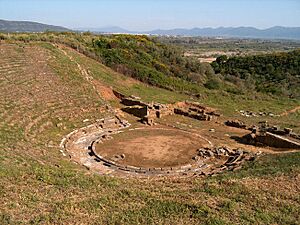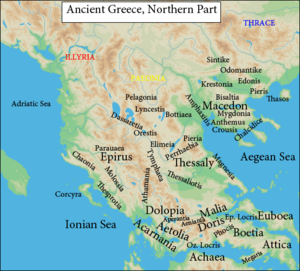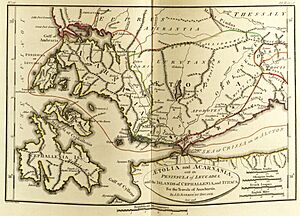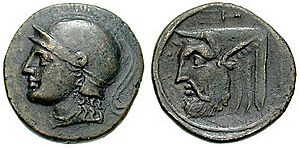Acarnania facts for kids
Quick facts for kids
Acarnania
Ἀκαρνανία
|
|
|---|---|
|
Region
|
|

Ruins of the theatre, Stratos
|
|

Map of ancient Acarnania
|
|
| Country | Greece |
| Location | Western Greece |
| Major cities | Stratos |
| Dialects | Doric |
Acarnania (Greek: Ἀκαρνανία, translit. Akarnanía) is an old region in west-central Greece. It's located along the Ionian Sea, to the west of Aetolia. The Achelous River formed its eastern border. To the north, part of Acarnania was near the Corinthian Gulf. Today, this area is part of the Aetolia-Acarnania region in modern Greece. In ancient times, the main city and capital was Stratos.
According to Greek mythology, Acarnania was founded by Acarnan, who was the son of Alcmaeon.
Contents
History
Early History of Acarnania
The name Acarnania wasn't known in the very oldest times. The ancient Greek poet Homer (who lived around 800 BC) simply called this area "Epeirus," meaning "mainland." He often mentioned the Aetolians, who were neighbors.
This land was first home to groups like the Taphii, Leleges, and Curetes. The Taphii were mostly found on islands near Acarnania's western coast. They were known for being pirates. The Leleges lived in many parts of Greece, including Aetolia and Locris. The Curetes came from Aetolia and settled in Acarnania.
The name Acarnania comes from Acarnan. He was the son of Alcmaeon and is said to have settled near the mouth of the Achelous River. This story suggests that a group from Argos (a city in Greece) settled here long ago.
Greek Influence and Early Conflicts
Around 600 BC, the Greeks started to have a bigger impact on the region. The city of Corinth founded new settlements like Anactorium, Sollium, and Leucas. Another city, Kefalonia, founded Astacus. The original people of Acarnania were pushed further inland. They didn't develop much in terms of art or city life.
Even during the Peloponnesian War, they were seen as a rough and wild people. They often fought with their neighbors and lived by stealing and piracy. Other settlements like Alyzeia, Coronta, Limnaea, Medion, Oeniadae, Palaerus, Phoitiai, and Stratus are also mentioned. Stratus was the main city of a group of Acarnanian towns called the Acarnanian League. This league lasted until the late 1st century BC.
The ancient Acarnanians were Greeks. They were allowed to compete in the famous Pan-Hellenic games. They were known for being loyal and brave. They made good light-armed soldiers and were excellent at using slings. They mostly lived in small villages. If attacked, they would retreat to the mountains.
The Acarnanians were part of a political League. The philosopher Aristotle even wrote about their government, but that work is now lost. Meetings of the League were usually held in Stratus. Later, during Roman times, meetings took place in Thyrium or Leucas.
Classical and Hellenistic Periods
Acarnania was important because of its location on the sea route to Italy. This meant it was involved in many wars. The Acarnanians disliked the settlers from Corinth. These settlers had taken over their best ports. This led the Acarnanians to side with the Athenians.
Their alliance with Athens began around 432 BC. This happened when Corinthian settlers from Ambracia drove the Amphilochians out of their town, Argos Amphilochicum. The Acarnanians supported the Amphilochians. They asked Athens for help. Athens sent an army led by Phormio, who helped them take back Argos.
An official alliance was then made between Acarnania and Athens. Only the towns of Oeniadae and Astacus did not join. The Acarnanians were very helpful to Athens in western Greece. They won an important victory in 426 BC. This was the Battle of Olpae, where they defeated the Peloponnesians and Ambraciots. After this, they made peace with the Ambraciots but stayed allies with Athens.
In 391 BC, the Acarnanians fought against the Achaeans. The Achaeans had taken over Calydon in Aetolia. The Achaeans asked Sparta for help. Sparta sent an army led by King Agesilaus. He attacked Acarnania, but his actions didn't have a lasting effect. While some Acarnanian cities surrendered to Sparta for a time, they later joined the Second Athenian League in 375 BC.
The Acarnanians then sided with the Boeotians against Sparta. They also fought with Athens against Philip II of Macedon at the Battle of Chaeronea.
After the time of Alexander the Great, around 314 BC, the Macedonian king Cassander ordered that smaller Acarnanian settlements near Aetolia be combined into fewer, larger ones. However, border fights with the Aetolians were common. Around 250 BC, Acarnania's land was divided between Aetolia and Epirus.
When the king of Epirus fell, the Acarnanian land that had been given to Epirus became independent again. Leucas became the new capital. But conflicts with the Aetolians continued. Because of this, the Acarnanians became close allies with the Macedonian kings. They stayed loyal to Philip during his wars with the Romans. They only surrendered to Rome after their main town, Leucas, was captured and Philip was defeated at the Battle of Cynoscephalae.
When Antiochus III, the king of Syria, invaded Greece in 191 BC, the Acarnanians were convinced to support him. But after Antiochus was driven out of Greece, they again came under Roman rule. After the Romans defeated Perseus in 168 BC, Leucas was separated from Acarnania. The city of Thyrreion was chosen as the new capital.
Roman and Byzantine Periods
In the 1st century BC, Acarnania suffered a lot from pirates and Roman civil wars. When Greece became a Roman province, it's not clear if Acarnania was part of Achaea or Epirus. Later, it was mentioned as part of Epirus.
Many people from Acarnanian towns were moved by Augustus to Nicopolis. He founded this city after the Battle of Actium. Acarnania then came under Nicopolis's control. During Augustus's time, the country was described as very tired and worn out.
In 395 AD, Acarnania became part of the Eastern Roman Empire. When the empire was attacked by Western powers in the Fourth Crusade (1204), Acarnania became part of the Despotate of Epirus. In 1348, it was conquered by Serbia. Then, in 1480, it fell to the Ottoman Empire. Since 1832, Acarnania has been part of modern Greece.
Modern Acarnania
Today, Acarnania is part of the larger Aetolia-Acarnania region in Greece.
Geography
Acarnania has three main types of land. First, there's a rocky coastline. Second, there's a rough strip of mountains that runs along the coast. Third, there are plains located between these mountains and the Achelous River.
In ancient times, Acarnania was considered the westernmost part of Greece. To the north, it was bordered by the Ambracian Gulf. To the northeast was Amphilochia. The Ionian Sea was to its west and southwest. To the east was Aetolia. The region covered about 1,571 square miles.
Under the Romans, the Achelous River formed the border between Acarnania and Aetolia. But during the Peloponnesian War, the town of Oeniadae, which was Acarnanian, stretched east of this river. The inner parts of Acarnania were covered with forests and mountains that weren't very high. Between these mountains were several lakes and many fertile valleys.
The main river in the area is the Achelous. In its lower part, it flows through a large, very fertile plain called the Paracheloitis. By the 1800s, this plain was covered with swamps. Much of it seemed to have been formed by the mud and soil carried by the Achelous River. Because of this, and because the river often changed its path, the southern coast of Acarnania has changed a lot since ancient times.
The main river that flows into the Achelous in Acarnania is the Anapus. It joined the Achelous about 9 miles south of Stratus.
There are several points of land (promontories) on the coast. Only two are often mentioned in old writings: the promontory of Actium and Crithote. Crithote is on the west coast and forms one side of a small bay where the town of Astacus once stood.
Of the lakes inland, only one is named by classical writers: Melite (Μελίτη). It was about 3.5 miles long and 2.5 miles wide. It was north of the Achelous's mouth, in the area of Oeniadae. There was also a lagoon, or salt lake, between Leucas and the Ambracian gulf. Strabo called this lake Myrtuntium (Μυρτούντιον).
Even though the soil of Acarnania was fertile, the people didn't farm it much. Ancient writers rarely mention what the country produced. Pliny talks about iron mines and a pearl-fishery near Actium. The main wealth of the people came from their herds of animals. These animals grazed in the rich meadows in the lower part of the Achelous valley.
Many islands were located off the western coast of Acarnania. The most important were the Echinades. These islands stretched from the mouth of the Achelous along the shore to the north. The Taphiae Insulae were between Leucas and Acarnania. Leucas itself was originally part of the mainland. But it was later separated by a canal.
List of Acarnanians
- Carnus, a seer of Apollo who helped start the worship of Apollo Carneus among the Dorians.
- Amphilytus, a seer for Peisistratos (Athens).
- Megistias, a seer at the famous battle of Thermopylae.
- Lysimachus of Acarnania, one of the teachers of Alexander the Great.
- Philip of Acarnania, one of the doctors of Alexander the Great.
- Machatas (sculptor), a sculptor.
- Aristomenes of Acarnania, a guardian and ruler for Ptolemy V Epiphanes.
- Alexander of Acarnania, a general for Antiochus the Great.
See also
- Acarnanian League
- List of cities in ancient Acarnania.
- List of cities in Acarnania
- List of traditional Greek place names




